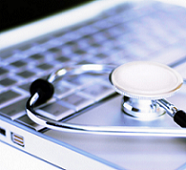 by Angela Kennedy, iHealthBeat
by Angela Kennedy, iHealthBeat
Lydia Washington, MS, RHIA, CPHIMS — senior director of HIM Practice Excellence at the American Health Information Management Association — contributed to this Perspective.
One year ago, I found myself putting in relentless effort to compile an accurate medical record for my daughter after she was diagnosed with the genetic disease Cystic Fibrosis at age 11. I experienced many frustrations in my attempt to gather my child’s medical records. Due to an incorrect entry in my daughter’s medical record, the inheritable condition was overlooked. The records included an inaccurate statement that had been copied and pasted into all subsequent records for nine years.
Gracie is just one example of why a commitment to consumers must be made that we can provide health information where and when they need it. We need a guarantee that information will be available, accessible, accurate and complete. Copy-paste and copy-forward pose risks to patient care. In my daughter’s case, perhaps if the information had been reviewed or audited for accuracy, she would have received an earlier diagnosis. This audit is not just the responsibility of the caregiver but also the responsibility of the patient.
Patients should routinely access and review records for accuracy. Since 2003, the federal HIPAA privacy rule has given individuals the right to examine and obtain copies of their health records, yet there is still widespread misunderstanding about these rights in the health care community, and barriers still exist for patients and families seeking full access to health records
Effective implementation of regulations and laws, and leveraging health IT for sharing of health information with both consumers and other providers, highlights the need for “rules of the road” or information governance. Without governance mechanisms that are agreed upon across the larger health care ecosystem, the U.S. will not be able to receive full benefit from its multi-billion dollar investment in health IT, let alone advance patient-centric care. Governance is needed to have high-integrity, reliable health information that can be trusted for health care decision making.
If we continue with a narrow focus on technology and without a focus on information governance processes and principles, the U.S. will continue to experience daunting challenges related to health information exchange and sharing, patient identification, and privacy and security. Patients will continue to be at a disadvantage in trying to manage their health without appropriate, trusted information. Information governance is the new imperative for advancing the use of health IT and health information to support patient-centric care.
And what about claims data? It was critical to providing a complete medical history for my daughter — the codes that remained and the charges associated with her visits helped to recreate the encounter. Addressing the current classification system is important, too. We should have been talking about the value of patient information and the classification of disease for population health long before now.
The ICD-10 implementation delay presents implications for providers, health plans, and state and federal agencies, but we must continue to advocate for ICD-10 implementation. ICD-10 will have tremendous value and impact on population health data and the consumer. It is imperative that we clearly articulate to the consumer the value of accurately coded data.
Things are rapidly changing, but we must navigate that change in ways that drive better decision making for patients and the providers who treat them. As health care professionals, we have been applying data analytics and informatics techniques for many years. The difference now is that the data are electronic, with multiple users at multiple settings applying multiple guidelines for collection, creation, storage, use and deletion. Data are being generated by mobile health and personal health devices. We have to make certain that we are using clean data to create health intelligence.
Care is important, but the information generated is what remains when the care is complete, and we can’t neglect the consumer’s legacy that is left for us to preserve and protect. Health care professionals encounter health care consumers daily. We know the benefits that access and use of personal health information can bring to the consumer and their families. But consider this: Over the past year, I have written numerous appeals to our insurance company to pay for an $18,000 vest for my daughter, and I have lobbied for prescription coverage for a $1,500 monthly prescription and supplement coverage for my daughter, all of which are vital to her care. I am a health care professional; I know how to get these things accomplished. What about the average consumer who is overwhelmed by a diagnosis and just trying to make it to the next day?
As we address these barriers, we must also keep in mind the health literacy levels of consumers. Health literacy can be defined as the degree to which individuals have the capacity to obtain, process and understand basic health information and services needed to make appropriate decisions. Only 12% of adults have proficient health literacy, according to the National Assessment of Adult Literacy. Fourteen percent of U.S. adults (30 million) have below basic health literacy. These people were more likely to report their health as poor when compared with those with proficient health literacy.
In our journey to remove barriers to accessible health information, we must ensure that it is understandable and actionable by consumers. Today’s models of health care demand a commitment to wellness. It is our challenge to educate consumers and local communities on the importance and value of personal health information. There is so much each and every one of us can do to make an incredible difference.
